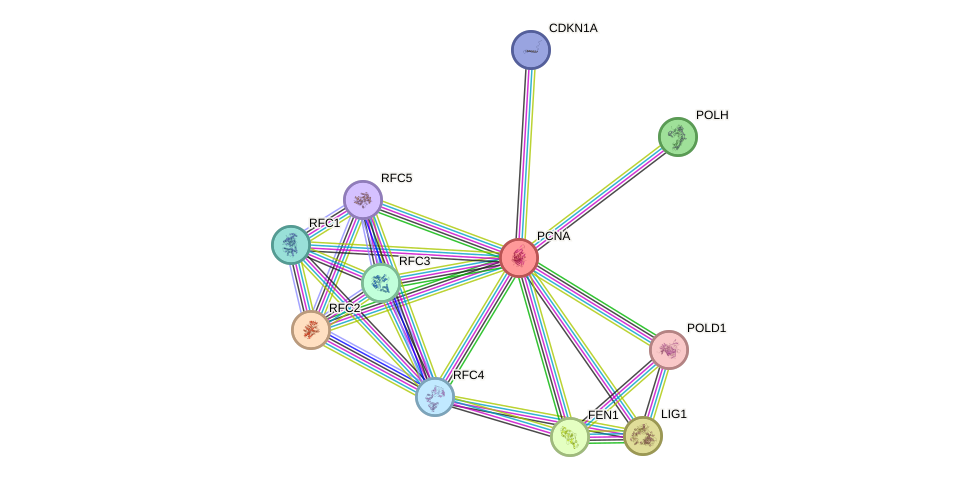GenAge entry for PCNA (Homo sapiens)
Gene name (HAGRID: 113)
- HGNC symbol
- PCNA
- Aliases
- Common name
- proliferating cell nuclear antigen
Potential relevance to the human ageing process
- Main reason for selection
- Entry selected based on evidence linking the gene product to a pathway or mechanism linked to ageing
- Description
PCNA is an important player in DNA replication and, probably, in DNA repair. It has been associated with pathways suspect of being involved in human ageing, and it interacts with WRN [440]. PCNA levels have also been linked to cellular proliferation in aged rats [581]. In humans, a hypomorphic PCNA mutation causes a syndrome displaying a neurodegenerative phenotype including short stature, hearing loss, premature aging, telangiectasia, neurodegeneration, and photosensitivity. Additionally, patient cells exhibit abnormalities in response to UV irradiation [3604]. Therefore, it is possible that PCNA influences human ageing even though more detailed studies are necessary to prove such hypothesis.
Cytogenetic information
- Cytogenetic band
- 20pter-p12
- Location
- 5,114,953 bp to 5,120,001 bp
- Orientation
- Minus strand
Protein information
- Gene Ontology
-
Process: GO:0000082; G1/S transition of mitotic cell cycle
GO:0000083; regulation of transcription involved in G1/S transition of mitotic cell cycle
GO:0000722; telomere maintenance via recombination
GO:0000723; telomere maintenance
GO:0006271; DNA strand elongation involved in DNA replication
GO:0006272; leading strand elongation
GO:0006283; transcription-coupled nucleotide-excision repair
GO:0006296; nucleotide-excision repair, DNA incision, 5'-to lesion
GO:0006297; nucleotide-excision repair, DNA gap filling
GO:0006298; mismatch repair
GO:0006977; DNA damage response, signal transduction by p53 class mediator resulting in cell cycle arrest
GO:0007507; heart development
GO:0008283; cell proliferation
GO:0016925; protein sumoylation
GO:0019985; translesion synthesis
GO:0030855; epithelial cell differentiation
GO:0031297; replication fork processing
GO:0032077; positive regulation of deoxyribonuclease activity
GO:0032355; response to estradiol
GO:0033683; nucleotide-excision repair, DNA incision
GO:0034644; cellular response to UV
GO:0042276; error-prone translesion synthesis
GO:0042769; DNA damage response, detection of DNA damage
GO:0044849; estrous cycle
GO:0045739; positive regulation of DNA repair
GO:0045740; positive regulation of DNA replication
GO:0046686; response to cadmium ion
GO:0070301; cellular response to hydrogen peroxide
GO:0070987; error-free translesion synthesis
GO:0071548; response to dexamethasone
GO:0097421; liver regeneration
GO:1902065; response to L-glutamate
GO:1902990; mitotic telomere maintenance via semi-conservative replication
Cellular component: GO:0000784; nuclear chromosome, telomeric region
GO:0005634; nucleus
GO:0005654; nucleoplasm
GO:0005657; replication fork
GO:0005663; DNA replication factor C complex
GO:0005737; cytoplasm
GO:0005813; centrosome
GO:0030894; replisome
GO:0043596; nuclear replication fork
GO:0043626; PCNA complex
GO:0070062; extracellular exosome
GO:0070557; PCNA-p21 complex
Hide GO termsFunction: GO:0000701; purine-specific mismatch base pair DNA N-glycosylase activity
GO:0003682; chromatin binding
GO:0003684; damaged DNA binding
GO:0005515; protein binding
GO:0019899; enzyme binding
GO:0030331; estrogen receptor binding
GO:0030337; DNA polymerase processivity factor activity
GO:0030971; receptor tyrosine kinase binding
GO:0032139; dinucleotide insertion or deletion binding
GO:0032405; MutLalpha complex binding
GO:0035035; histone acetyltransferase binding
GO:0042802; identical protein binding
GO:0070182; DNA polymerase binding
Protein interactions and network
- Protein-protein interacting partners in GenAge
- TP53, ERCC8, WRN, EGFR, PARP1, BRCA1, CREBBP, RPA1, ABL1, BRCA2, TOP1, RAD51, ERCC6, EP300, PRKDC, ERCC5, XRCC5, PCNA, FEN1, XRCC6, POLD1, FOXO3, HDAC1, CCNA2, EEF1A1, ATF2, APEX1, POLA1, MDM2, CDKN2A, POLB, MLH1, CDKN1A, SPRTN
- STRING interaction network
Retrieve sequences for PCNA
Homologs in model organisms
- Caenorhabditis elegans
- pcn-1
- Danio rerio
- pcna
- Drosophila melanogaster
- mus209
- Mus musculus
- Pcna
- Rattus norvegicus
- Pcna
- Saccharomyces cerevisiae
- POL30
- Schizosaccharomyces pombe
- pcn1

